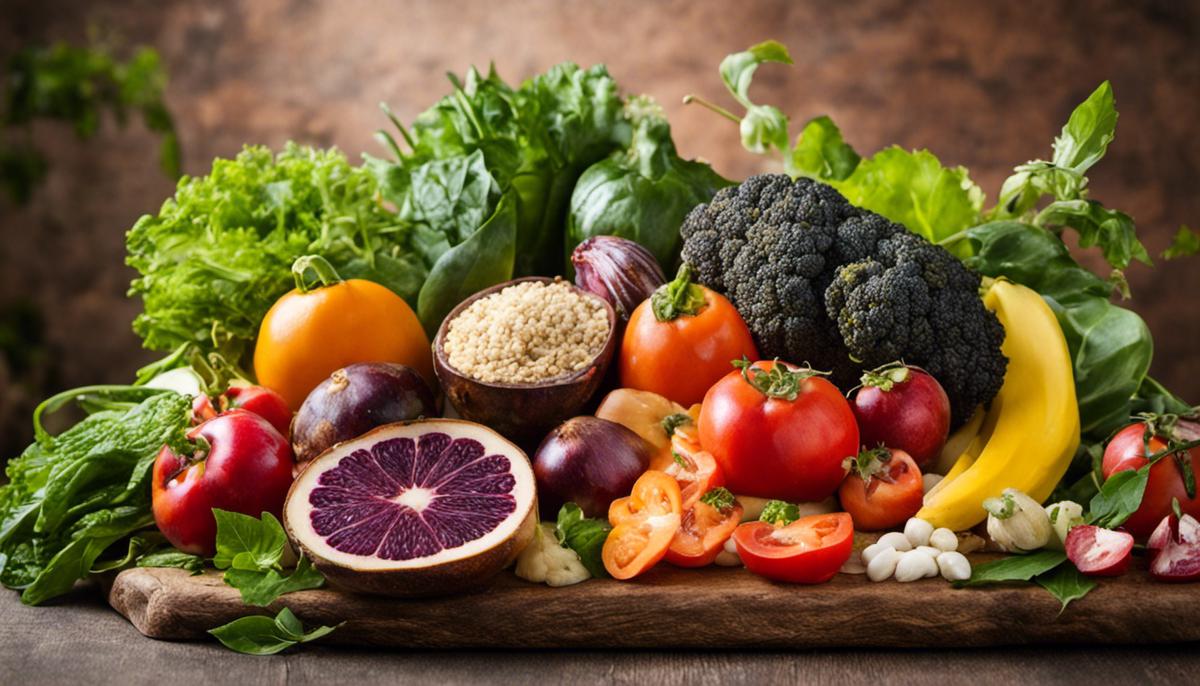The abundant, sprawling world of organic cooking spills over into our lives with all the grace of a sun-soaked vineyard; alive with rich flavors, radiant health benefits, and a depth of culinary possibilities. Whether you’re a curious amateur or a seasoned home chef, navigating this immense landscape of organic food can be as daunting as it is rewarding. Having a comprehensive understanding of organic cooking principles is foundational to the journey. This includes being well-versed in sourcing sustainably and locally, deciphering organic labeling, and appreciating the benefits of organic ingredients. Tuning into the myriad of organic ingredients, from seasonal produce to grains, dairy, and meat, amplifies the quality, taste, and overall enjoyment of your culinary creations. Ingenious cooking techniques and thoughtful preparations can further preserve natural tastes, minimize waste, and enhance ingredients. And, when it’s time to savor your labor of love, understanding the art of tasting and pairing organic food with beverages takes the dining experience from nourishing to tantalizing. This exploration aims to provide an essential roadmap, inviting you into the incredible world of organic cooking.
Understanding the Basics of Organic Cooking
Reveling in the Rhythms of Organic Cooking: A Taste of Essence and Principles
In the vibrant realm of gastronomy, organic cooking stands tall, reigning in both the hearts of gourmets and eco-conscious food enthusiasts. The very essence of organic cooking is deeply intertwined with Mother Nature. It’s about minimalism, simplicity, and amplifying the natural flavors of sustainably raised, chemical-free produce. Plus, oh boy, nothing quite meets the glory of biting into a sunny, succulent tomato freshly picked from an organic garden.
At the heart of organic cooking lies the principle of sustainability – enhancing the soil and water quality, reducing pollution, and fostering a healthier ecosystem for the present as well as future generations. It connects food and the environment in a natural symphony. A gastronomic ballet where flavors dance poetically across the palate.
A magical aspect of organic cuisine lies in its seasonal symphony. Relishing succulent summer berries or hearty winter root veggies at the peak of their season not only guarantees a burst of flavors but also maximizes nutritional content. Bravo to the medley of unmatched freshness and crispness that each season brings!
One significant tenet of organic cooking patrols the ethos of ‘no waste’. Using every part of the vegetable, from root to stem and leaf, or nose to tail animal utilization. Seek out the delicate sweetness in beet greens or the rustic richness of bone broths. It’s a joyous rebellion against the throw-away culture.
Creating a perfect harmony between food synergy and nutritional benefits is another exciting revelation. It’s fascinating how the nutrient profiles of some foods amplify when paired together. Think bright summer salads enriched with a drop of lemon juice, enhancing the body’s absorption of iron from those lush green leaves. SPECTACULAR!
Additionally, organic cooking encourages a much deeper appreciation for local produce. Frequenting the local farmers’ market, where hearty congratulations flow freely alongside local, fresh produce – Is there a more delightful way to spend a Saturday? Besides, buying local means supporting local communities while reducing the carbon footprint left by transportation. All while serving up a lip-smacking meal; it’s a victorious triple-win situation.
Also, the principle of minimal processing swings at the core of organic cooking—maintaining organically grown, no added hormone meat, or unprocessed grains. This helps retain the authentic flavors and nurture the beneficial nutrients.
Organic cooking is a magical journey into the depths of Nature’s pantry. It is a celebration of ethically sourced, nutrition-packed, health-boosting ingredients savored at their unhindered best – a pledge that every conscientious connoisseur should savor. As our palates dance to the rhythm of organic, it binds us closer to our earth, our providers, and our friends around the table.
And let’s remember, the grand finale at every kitchen or dinner table is the love and passion of those who craft these organic masterpieces. The joy of sharing a meal that radiates with health and happiness is surely beyond comparison. Organic cooking is not just about preparing a meal but about sowing seeds of a more sustainable, healthier future—a future sewn together with the golden threads of age-old culinary wisdom and the anticipation of many shared meals to come.

Exploring Organic Ingredients
“Exploring the Flavor Spectrum of Organic Ingredients”
Stepping into the world of organic ingredients immerses any culinary connoisseur in a refreshing palette of flavors and aromas that comes from treating our Planet with kindness. From vegetables to herbs, dairy to grains, and lean meats to fish, these natural players offer a range of features that can undeniably enhance the quality and taste of dishes.
Organic fruits and vegetables are known for their exemplary freshness, full nourishment, and amplified taste. Their journey from the soil to the plate is one of integral love and respect for our natural world. The absence of synthetic fertilizers and pesticides allows these plant ingredients to grow at their own pace, bearing true flavors and textures that are often more robust and nuanced. They blend harmoniously in recipes, sharing their flavors without overpowering each other. A tangy organic tomato or a plump organic blueberry bursts with such vibrancy that they elevate any dish they are a part of.
Next up on this diverse palette are organic dairy products and eggs. Free of antibiotics and growth hormones, these components bring a creamy, rich flavor to dishes that is exceedingly delightful. The animals are usually fed pure, organic food and raised humanely, which impacts the overall quality and taste that eventually translates to your dishes. Imagine mouthwatering Scrambled Eggs made from rich organic eggs or a Cheesecake with a heart of pure organic cream cheese – the taste is just extraordinary!
Organic grains and legumes, grown sustainably without the use of synthetic pesticides or fertilizers, also impart a distinct, wholesome flavor to dishes. They add a depth and character to recipes due to their inherent natural nutrients, which give each grain or legume its unique texture and taste. Quinoa salads, lentils soups, or oat bread created with organic grains and legumes provide a wholesome, hearty bite that reaffirms its organic origins.
In the realm of organic meats and seafood, both occupy a unique position. These organic proteins come from animals that unspool their lives naturally, graze on naturally grown pastures or swim freely. Consequently, the flavors are genuinely superior compared to conventionally raised ones. Be it a pan-seared organic salmon, spit-roasted organic chicken, or a slow-cooked organic pork shoulder, the result is always promisingly delectable.
Last, but certainly not least, are the numerous organic herbs and spices which give dishes unique layers of flavor. Whether they are adding a kick of heat, a refreshing zest, or a delicate sweetness, organic herbs and spices are superior in flavor and aroma since they aren’t irradiated like many conventional spices.
In conclusion, exploring the culinary landscape through the lens of organic ingredients allows for a unique opportunity to taste Mother Nature in the most magnanimous of ways. With each organic ingredient, dishes gain a new depth and complexity. An opportunity arises for innovative cooking methods that empower their taste and nourishment while sustaining our planet. This is both the beauty and joy of incorporating organic ingredients into the kitchen. Delicious and responsible – what a delightful combination!

Organic Cooking Techniques
With the first part of this article already outlining the core concepts and values of organic culinary arts, let’s delve into some impactful cooking techniques that can accentuate the flavors and nutritional benefits of organic ingredients.
When it comes to organic fruits and vegetables, it’s all about freshness. Techniques such as blanching, steaming, or light sautéing allow for maximum preservation of the vibrant flavor and nutritional value. Too much heat for too long can strip these ingredients of their natural beauty. The delicate nuances of organic produce can really shine through with these techniques.
Next up, organic dairy products. Make no mistake, these are not your average dairy products. The creamy, rich flavors can transport you to a pastoral paradise. Slow cooking techniques like simmering and reduction are often employed to coax out this creaminess and richness in dishes. Gentle heat is the secret here as high temperatures can curdle or separate dairy components.
Switching gears to organic grains and legumes, they carry a distinct, wholesome flavor that’s hard to miss. The best way to bring out their taste is through slow cooking or pressure cooking. Contrary to common belief, slow cooking doesn’t mean a loss of nutrients. It keeps the integrity of the grains and legumes while thoroughly cooking them. In the case of pressure cooking, it reduces cooking time significantly, yet preserves the nutritional value.
When it comes to organic meats and seafood, the superior flavors compared to conventionally raised ones are remarkable. The techniques for maximizing this range from marinating, slow-cooking, braising, grilling to sous-vide – yes, organic food can embrace modern culinary technologies too. Marinating is an age-old strategy to imbue meats with flavor, while basting during grilling can maintain juiciness. Slow-cooking or braising tenderize the meat, breaking down the tough fibrous tissues leaving you with melt-in-mouth goodness. What about sous-vide? It’s the ace in the hole when it comes to preserving nutrients, maintaining the integrity of the ingredient, and injecting flavor.
Finally, talk about organic herbs and spices! Their unique layers of flavor could be the quickest way to transport your senses in a few bites. Fresh herbs are best added at the end of cooking to preserve their flavor and color. As for spices, mastering the art of ‘blooming’, where spices are lightly fried in oil or butter, can unlock their full flavor potential.
Ultimately, the beauty of cooking with organic ingredients lies within the taste, quality, and sustainability they bring to the table. It’s about cherishing nature’s bounty, exploring new techniques, and savoring glorious food while caring for our planet. Each cooking technique underlines the different characters embedded in these organic ingredients and guides us to enjoy food in its purest form. Combining organic produce with these effective cooking techniques not only results in delectable meals but also contributes to the health of the environment and the soul of the community.

Tasting and Pairing Organic Cuisine
In the dance of gastronomy, understanding the rhythm of organic food is equally essential as having the knowledge of what spices should go with which ingredient or knowing the precise time to flip that sizzling steak on your hot, inviting grill. It’s like perfecting dance moves, where one must know which steps to follow to deliver a fantastic finale.
While we’ve already touched deeply on organic foods, their rich flavors, their contribution to sustainability, and the mastery of various cooking techniques, there’s still a component to uncover that will maximize the potential of organic cooking.
“Pairing”. A principle that sometimes takes a back seat in our culinary adventures, but one of vital importance. It not only complements and enhances the flavors of our organic ingredients but also drives us towards a more innovative and delightful dining experience.
What does this involve? It largely revolves around unearthing the ‘perfect match’’ for your organic food. Think of it as courtship, where like personalities tend to meld and match. Ditto with food! A robust organic red wine dances flawlessly across a palette filled with a bold, tangy organic cheese. Warm bread out of the oven, caressed by butter derived from organic cream, elevates the simplest meal.
Look at organic meats. When paired with the right organic herbs and spices, they evolve from ordinary to extraordinary. Savour a juicy organic chicken breast marinated with rosemary or savor a tender organic steak seasoned with thyme and garlic. The burst of flavors is unmistakable.
Consider the role of sauces as well. This is where an organic tomato, slowly simmered with organic onions and garlic, morphs into a versatile sauce lapping up a pan-fried organic fish fillet or saucy organic pasta. The sauce, simmering with various organic herbs, raises plain food to a gourmet level.
Take organic grains and legumes. While hearty and nourishing on their own, they reach new heights flavored with organic coconut oil or butter, sprinkled with ground organic spices and garnished with a flurry of fresh herbs. It’s not just a meal – it’s an immersive dining experience.
Similarly, the thrill of finding the perfect organic dessert wine to sip with a slice of indulgent organic chocolate cake or discovering the right organic coffee to accompany your morning organic biscuit is intrinsic to this food journey.
Simple? Yes. But remember, the magic lies in the ‘mix and match.’ Just as you would never mix stripes and polka dots, don’t pair spicy foods with heavily tannic wine. Keep the idea of flavor harmony at the center of your culinary choices. Experiment, but let your creativity rest on a firm foundation of culinary wisdom.
There’s no denying – great organic food can stand on its own. But wouldn’t the meal reach an unrivalled level of gastronomic delight if combined with the ‘perfect match’? It’s like a beautiful waltz, a delightful symphony, or an exciting novel. All the elements come together to create an experience that is more than just the sum of its parts.
In conclusion, dive into the world of organic food pairing and complete your journey to full organic appreciation. Join the dance, and don’t be merely a spectator. The kitchen is calling with an open invitation. It’s time to create your own organic masterpiece.

Recipes and Creating Your Own Organic Dishes
Embarking on the journey of organic cooking can seem daunting. However, it need not be. To lessen the anxiety that may accompany the introduction to organic foods, here are some great starter recipes:
- Organic roasted vegetables: A simple and enticing exploration into the natural flavors of organic veggies. Toss a mix of seasonal vegetables with an organic olive oil, some salt, spices, and herbs. Roast until tender and finish with a squeeze of fresh lemon juice.
- Organic chicken stew: Organic chicken thigh pieces, mixed with organic seasonal vegetables, slow cooked with herbs and flavors can make a comforting meal.
- Organic green salad: A delightful mix of crisp organic lettuce, fresh organic tomatoes, crisp cucumbers, and other seasonal greens tossed in a simple homemade vinaigrette.
- Organic grain bowls: Choose a favorite grain like quinoa or couscous. Toss it with roasted vegetables, organic greens, and a dollop of hummus for a quick and satisfying meal.
- Organic berry parfait: For dessert or breakfast, layer organic Greek yogurt, granola, and fresh, organic berries in a glass and enjoy.
Creating your own organic dishes starts by recognizing the natural flavor profiles. Don’t cover the taste with heavy sauces, enjoy the food in its purest form. Experiment with pairing flavors, similar modalities or opposites to create a balance of taste. Challenge your taste buds and let them explore the different tastes of organic food.
When preparing food, choose earth-friendly cookware, such as cast iron skillets, and avoid non-stick pans that may release harmful chemicals when heated. Using sustainable cookware not only imposes a lesser environmental impact, but it also complements the true ethos of organic cooking.
Remember, organic cooking isn’t about being perfect. It’s about making better choices, one meal at a time. It’s about knowing the source of your foods, understanding the process it’s undergone before reaching your plate, and appreciating the purity of its taste.
So dare to try something new today! Trust in the process of organic cooking. Taste and feel the difference. Delight in creating dishes that are good not just for you, but for the Earth as well. Take your culinary journey a step further and dive head first into the world of organic cooking. Go ahead, the kitchen awaits!

So, we see that organic cooking isn’t just about the ingredients we use, but the way we use them. From sourcing responsibly and understanding food labels, to mastering cooking techniques and tantalizing tastebuds with the art of pairing, every aspect brings its own flavor to the table. Beyond these, creating organic dishes by yourself, or following organic recipes, epitomizes the true spirit of this realm. It is a refreshing blend of creativity, inspiration, and hands-on experience. This isn’t a mere cooking style, it’s a transformative journey – one that respects our health, our taste buds, and the very Earth that feeds us. Savor every step, relish each bite, as you navigate your own path through organic cooking. Because, at the end of the day, the heart of organic cuisine is about restoring the joy of cooking and savoring real food. So, go ahead, explore, create, and most importantly, enjoy.





